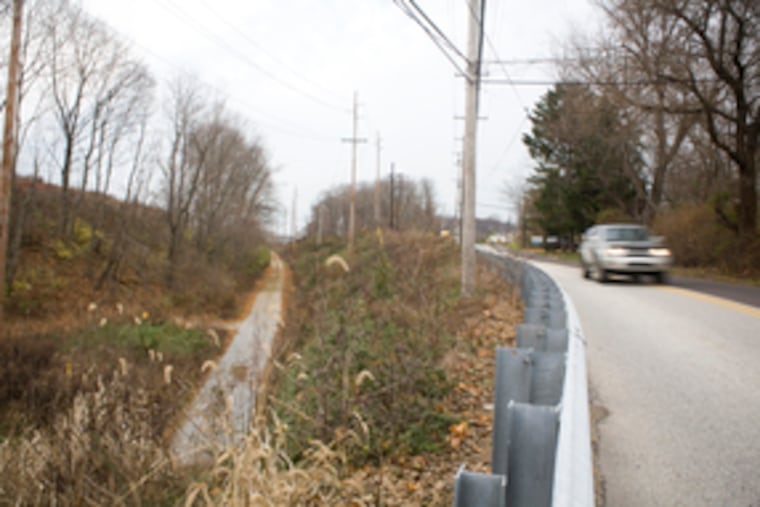A long and winding road to building Chesco trail
In 1991, when plans for the Chester Valley Trail were announced, Ingrid Cantarella-Fox and her husband, Dennis, were thrilled. He could ride his bike on it, and she could go for a run. The conversion of an abandoned railroad track to a hiking and biking trail near their Paoli home would be a dream come true.

In 1991, when plans for the Chester Valley Trail were announced, Ingrid Cantarella-Fox and her husband, Dennis, were thrilled.
He could ride his bike on it, and she could go for a run. The conversion of an abandoned railroad track to a hiking and biking trail near their Paoli home would be a dream come true.
Dennis Fox died seven years later, his dream unfilled. Ingrid Cantarella-Fox, now 64, is still running and still waiting.
"All of us runners and bikers have been looking forward to this trail for 15 years," she said. "I would like to find a way to get it completed."
That may finally happen.
Chester County officials, aided by a new design consultant and a pledge of construction funding from PennDot, say the 11.5-mile Chester Valley Trail will actually be built, though construction is still more than a year off.
It would link Exton to King of Prussia with a 16-foot-wide paved trail, and connect to the region's much larger rails-to-trails network.
"I would like to think we have this ball rolling," said John Mikowychok, director of Chester County's Parks and Recreation Department. "I think we are on the downhill side of the sled run."
Converting an abandoned 19th-century rail line into a trail running through a heavily developed and congested area takes a lot of time, ingenuity and effort, he said.
"It makes the trail far more complex to site, but it's well worth waiting for," he said.
Preliminary cost estimates are approximately $16 million, said Don Thompson, who oversees major construction projects for Chester County. Eighty percent is federal money, 20 percent is from the county.
The trail was to have passed through a Vanguard Group Inc. campus in Tredyffrin Township, but after 9/11, the company restricted access, so the route has been moved, Thompson said.
Design and engineering plans are on track for approval by PennDot late next year with construction following in 2009, said Ryan Gallagher, project manager for PennDot. That agency controls the federal funds.
Besides recreation, the trail, which runs parallel to Route 202, will also offer a way for bike-riding commuters to reach Vanguard and the Great Valley Corporate Center in East Whiteland Township without sitting in rush-hour traffic, Mikowychok said.
Also, Montgomery County is in the final design phase for a four-mile, $7 million extension of the trail that will link King of Prussia to the Schuylkill River Trail in Norristown. An additional one-mile stretch that includes a bridge across the Schuylkill Expressway opened in June 2004.
When that and the western sections are finished, the trail will link to a system that will run from Philadelphia to King of Prussia, Valley Forge National Historical Park, Downingtown, and even to Green Lane Park in northwestern Montgomery County.
Those and other trails have made the region a kind of urban trail mecca, said John Wood, who oversees the planning and development of trails for the county.
"I would look to Washington, D.C., as the only one that comes close to us," he said.
According to the Rails to Trails Conservancy, a Washington-based advocacy group, Pennsylvania's rails-to-trails miles rank it among the top five states in the country.
Of the nation's 13,935 rails-to-trails miles, 1,232 of them are in Pennsylvania. Only Wisconsin, Minnesota and Michigan have more.
In the 1970s and 1980s, railroad companies were abandoning a number of underused lines, which in rural areas formed natural greenways, many of them along rivers and streams, said Diane Kripas of Pennsylvania's Department of Conservation and Natural Resources.
"Astute counties were able to pick them up," Kripas said.
The trails have turned out to be economic powerhouses for the small towns they pass through, as folks hop off their bikes and grab a meal at a local restaurant or stay overnight at a bed-and-breakfast.
About 300,000 people use the Schuylkill River Trail, which runs from Oaks to Philadelphia, each year, and 200,000 travel the Perkiomen Trail, from Green Lane to Oaks, Wood said.
"Once the Chester County Trail gets to Exton, I know that's going to be extremely busy," he said.
The Chester Valley Trail itself may be a relatively short line, but the saga of converting the rail line is long and winding.
In the early 1990s, the county won $2.4 million in federal grants. Acquisition of the rail line was completed in 1996.
Seven years ago, the county opened a small section, about 1.5 miles long, near Exton.
Then the trail just fell off the radar.
Bob Morrison, chairman of the Chester County Parks and Recreation Advisory Board, said the original design firm "did not produce work in a timely fashion. Ultimately, they were replaced," he said.
Gallagher, of PennDot, expects to receive a final budget from the county, including the cost of repairing 15 stone-arch culverts, by next week.
"There is a commitment from PennDot to fund this project," Gallagher said.